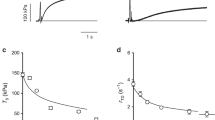Summary
Ten patients suffering from advanced myotonic dystrophy with severe myotonic symptoms were treated with 800–1200 mg/day of the anti-arrhythmic drug tocainide (Xylotocan). All patients reported a marked subjective improvement of myotonia, which was confirmed by objective tests. Except for a slight QT-prolongation in one patient, the ECG was not significantly altered by the treatment. Twenty-four-hour ECG after treatment disclosed that pre-existing ventricular arrhythmia disappeared in three cases. The occurrence of complex ventricular arrhythmia in two patients under treatment was not necessarily due to specific effects of the drug but might be explained by the high spontaneous variability of rhythm disorders. In these patients suffering from myotonic dystrophy with typical cardiomyopathy no deleterious effects of the drug were observed, especially no cardiac arrhythmias which would have necessitated interruption of treatment. Therefore, the authors recommend symptomatic therapy with tocainide for myotonia and paramyotonia congenita, as well as in myotonic dystrophy patients suffering from marked myotonic stiffness. ECG and 24-h ECG should be carefully recorded as necessary in any treatment with anti-arrhythmic drugs.
Similar content being viewed by others
References
Anderson JL, Mason JW, Winkle RA, Meffin PJ, Fowles RE, Peters F, Harrison DC (1978) Clinical electrophysiological effects of tocainide. Circulation 57:685–691
Birnberger KL, Rüdel R, Struppler A (1975) Clinical and electrophysiological observations in patients with myotonic muscle disease and the therapeutic effect of N-propyl-ajmalin. J Neurol 210:99–110
Bleifeld W (1971) Side effects of antiarrhythmic drugs. Naunyn-Schmiedebergs Arch Pharmacol 269:282–297
Burger L, Mielke U, Sen S, Stober T, Rettig G, Schieffer H (1984) Holter-EKG-Untersuchungen bei Myopathien. Fortschritte der Myologie, vol VII. DGBM, Freiburg, pp 399–404
Caughey IW, Myrianthopoulos NC (1963) Dystrophia myotonica and related disorders. Charles C Thomas, Springfield, Illinois, p 35
Church SC (1967) The heart in myotonia atrophica. Arch Intern Med 119:178–181
Dengler R, Rüdel R (1979) Effects of tocainide on normal and myotonic mammalian skeletal muscle. Arzneimittelforschung 29:270–273
Griffith TW (1911) On myotonia. Q J Med 5:229–249
Griggs RC, Davis RJ, Anderson DC, Dove JT (1975) Cardiac conduction in myotonic dystrophy. Am J Med 59:37–42
Karli P, Viitasalo MT, Kala R, Eisalo A (1982) Ambulatory electrocardiographic recording in patients with myotonic dystrophy. In: Abstracts of Free Communications of the 5th International Congress on Neuromuscular Diseases, September 12–18, Marseille
Lown B, Wolf M (1971) Approaches to sudden death from coronary heart disease. Circulation 44:130–142
Ludatscher RM, Kerner H, Amikam S, Gellei B (1978) Myotonia dystrophica with heart involvement: an electron microscopic study of skeletal, cardiac, and smooth muscle. J Clin Pathol 31:1057–1064
Munsat T (1967) Therapy of myotonia. A double-blind evaluation of diphenyl-hydantoin, procainamide, and placebo. Neurology (Minneap) 17:359–367
Ricker R, Haass A, Rüdel R, Böhlen R, Mertens HG (1980) Successful treatment of paramyotonia congenita (Eulenburg): muscle stiffness and weakness prevented by tocainide. J Neurol Neurosurg Psychiatry 43:268–271
Rüdel R, Dengler R, Ricker K, Haass A, Emser W (1980) Improved therapy of myotonia with the lidocaine derivate tocainide. J Neurol 222:275–278
Senges J, Rüdel R, Schmid-Wiedersheim E (1972) Effect of sparteine on normal and myotonic mammalian skeletal muscle. Naunyn-Schmiedeberg's Arch Pharmacol 274:348–356
Senges J, Rüdel R, Kuhn E (1973) Effects of quinidine, procaine amide, and N-propyl-ajmalin on skeletal muscle. Naunyn-Schmiedebergs Arch Pharmacol 276:25–33
Thomson AMP (1968) Dystrophia cordis myotonica studied by serial histology of the pace maker and conducting system. J Pathol 96:285
Winkle RA, Meffin P, Harrison DC (1978) Long-term tocainide therapy for ventricular arrhythmias. Circulation 57:1008–1016
Wolf A (1936) Quinine: an effective form of treatment for myotonia. Arch Neurol Psychiatry 36:382–383
Author information
Authors and Affiliations
Rights and permissions
About this article
Cite this article
Mielke, U., Haass, A., Sen, S. et al. Antimyotonic therapy with tocainide under ECG control in the myotonic dystrophy of curschmann-steinert. J Neurol 232, 271–274 (1985). https://doi.org/10.1007/BF00313863
Received:
Revised:
Accepted:
Issue Date:
DOI: https://doi.org/10.1007/BF00313863




